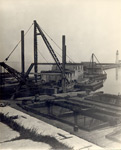New Invention
- Publication
- Oswego Daily Advertiser & Times (Oswego, NY), 24 Aug 1869
- Full Text
- New Invention - Important to Vessel Owners and Masters -
A Modern Mode of Furling Gaff TopsailsIt is an old adage that the idea is the father to the thought. So it is true with several important inventions that have been brought to notice during the present season of navigation, prominent among which is the mode of reefing, setting and furling gaff topsails - the inventor of which is Capt. George A. Ford, of Oswego, N.Y., and is without doubt worth more than a passing notice. Without dilating on the subject, we will proceed to give a brief but accurate sketch of the working of a modern gaff topsail.
It is a sail which has fifty-three feet hoist and thirty-eight feet gaff, and can be taken in and rolled up snugly, or set in any weather, in two minutes, and a the same time obviate the necessity of a man going aloft - besides making it safer, and having the use of one or two more men, as the case may demand, on deck, oftentimes when most needed. The sail is also more free from being chafed than by the old way, also making it wear longer, besides doing away with clew-lines, sheets, tacks, hoops, gaskets and blocks - the first of which are always wearing out, and need renewing.
In a squall, by letting go the halyards, the sail will instantly drop to the leeward of the canvas and lay becalmed, from where it became rolled up closely, as if lowered down, should there be time. If such should not be the case, the sail does not come in contact with the halyards and the lower sails are immediately settled down.
Another great feature of this invention is that the sail can be "set"over reefed canvas and made smaller or larger - as the case may demand by rolling it down. In tacking the ship the sail is readily shifted from one stay to the other by a messenger, passing the halyard over the masthead down to the jaws of the gaff when it is sprung into the head of the sail again. It is (the sail) then ready for hoisting, the roping of the sail running up the guide grooves abaft the topmast, which holds the luff securely to the mast and the tack and clew together with the foot of the sail, which is bent to a shaft along the gaff, thereby making it better "setting" than by the old style.
In conclusion, it would be well to state that only two ropes are used in connection with the sail. As before stated, the invention brought out has been in use during the present season of navigation, and that on the schooner Senator Blood, of Oswego, N.Y., of which the inventor is Master. During the last trip to this port, the Senator Blood was visited by quite a number of our leading vessel owners, and others interested who were unanimous in pronouncing the modern mode of furling and reefing gaff topsails a grand success. In fine, the day is not far distant when the "sail" in question will be used on our largest class of vessels, and ultimately universally adopted. - Chicago Tribune
- Media Type
- Newspaper
- Text
- Item Type
- Clippings
- Date of Publication
- 24 Aug 1869
- Subject(s)
- Personal Name(s)
- Ford, George A.
- Collection
- Richard Palmer
- Language of Item
- English
- Creative Commons licence
 [more details]
[more details]- Copyright Statement
- Copyright status unknown. Responsibility for determining the copyright status and any use rests exclusively with the user.
- Contact
- Maritime History of the Great LakesEmail:walter@maritimehistoryofthegreatlakes.ca
Website:


